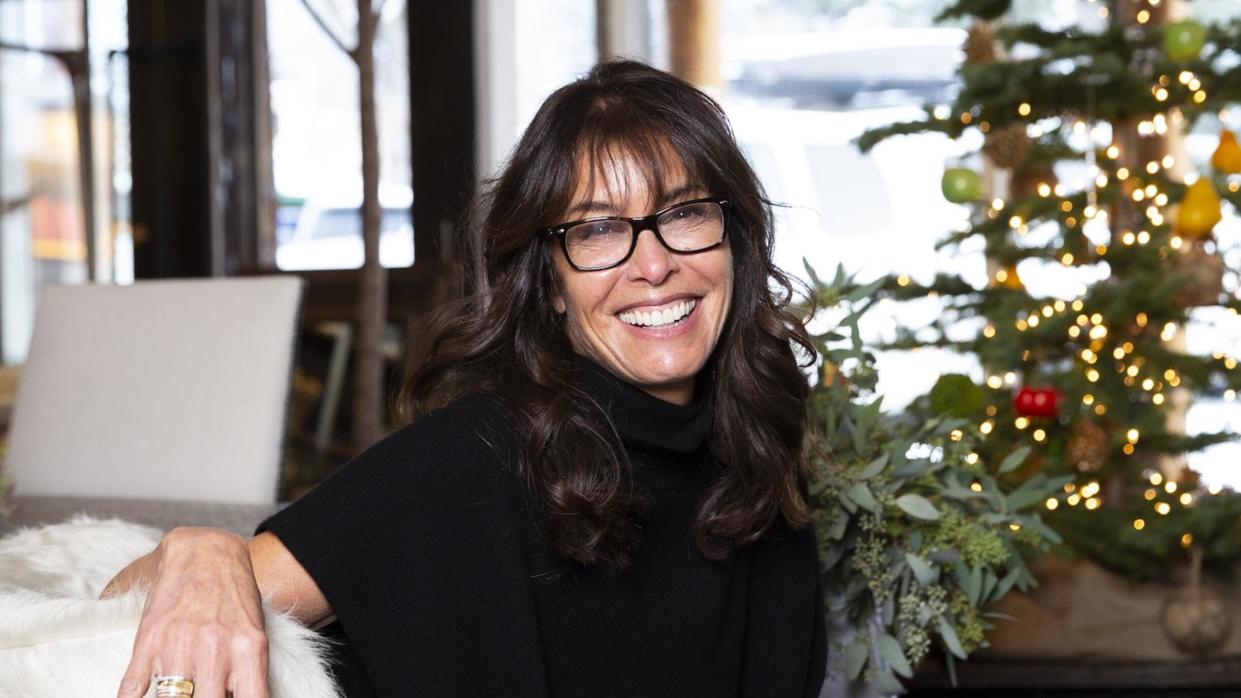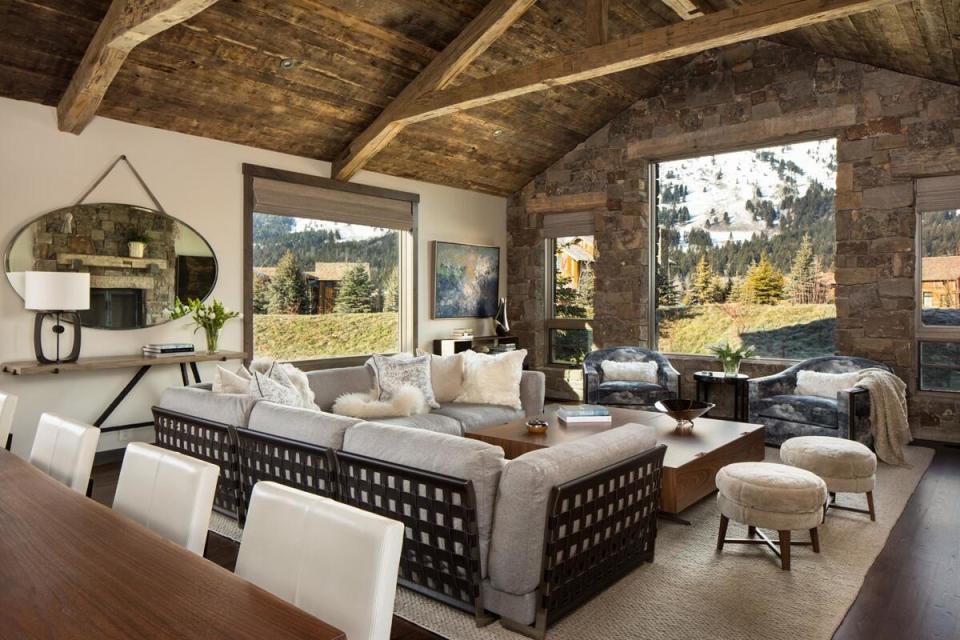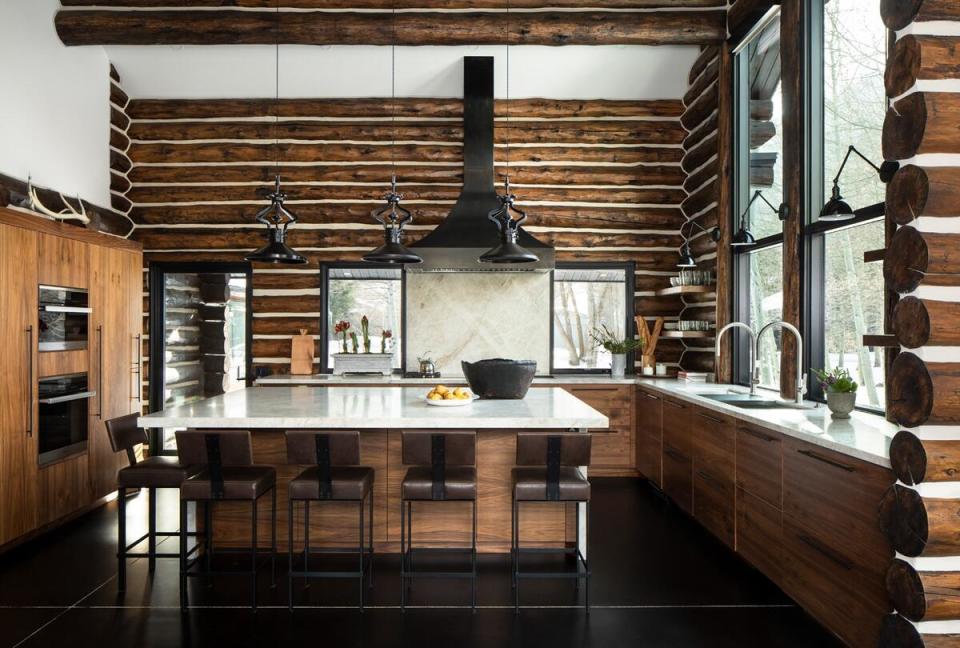How this Wyoming designer uses her own home as a sales tool

50 States Project | Dec 22, 2023
The 50 States Project is a series of candid conversations with interior designers across the country about how they’ve built their businesses. This week, Jackson, Wyoming–based designer Elisa Chambers of Snake River Interiors tells us about building a design and retail career in a destination ski town, creating an aesthetic that balances comfort and style, and embracing remote hires.
What was your path into the design industry?
My mother was an avid antiquer. She loved old things. But we also didn’t have any money, so she would go to garage sales out of necessity, buy beautiful things and decorate with those. She and my father would refinish the furniture, and it was amazing—I still have pieces in my home that they had refinished—so that was my first look into design and furnishings.
I grew up in Philadelphia, and then my family moved to California. I was doing small projects at the time, and then I started dating this guy who very casually said to me, “Interior designers, they’re a dime a dozen. They’re like models and actresses—you can never make a living doing that.” I’ll never forget that. He told me, “You should do something different—be a nurse.” And I thought, “Well, that’s really interesting.” So I went to nursing school and worked part-time in nursing, but I was still buying properties and selling them after fixing them up.
So you never really let it go.
Later, I went back and got another pair of bachelor’s degrees in sociology and psychology, and then my master’s in psychology, and I opened a private therapy practice. I found that I really loved learning—and interior design is all about learning too. As a designer, I’m constantly learning about people—what makes them feel happy, what “cozy” means to them, how they visualize their emotions. Getting into people’s heads is a big part of interior design.
When I moved to Wyoming, I was working as a nurse in the hospital—because how do you break into the interior design field in a new place? It’s a difficult field even when you are well-known. But I bought a piece of property and started to remodel it, and after I sold that house, the person who bought it needed other things, so I started helping them. My husband and I bought another property together, and the architect we used relied on me for all the interior architecture. That’s how Snake River Interiors blossomed. At that time, in 1998 or 1999, [Jackson] was just starting to catch on, and my husband said, “This is the perfect time for you to start a business.” And so I did.

What does your business look like today?
We always have approximately 10 projects. Half of them are full builds, and the other half are clients who have done full builds in the past and need something else—it’s a lifetime kind of commitment to our clients, which is nice because I get to see their families grow up. We also have a retail store called Twenty Two Home. [There are] 23 counties in Wyoming and every one has a number—ours, Teton County, is 22. I’ve always had furnishings in my design studio, because it’s nice to see more than just a desk and a bunch of fabric hanging everywhere when people walk in. It’s nice to feel what you’re paying for. That grew into a shop 12 or 13 years ago.
We are an all-female team. I have two designers who work remotely—they worked for me here in Jackson, and now they just come and visit once every six weeks. I have another designer who works with me in-house, two people in billing and accounting and HR who wear many hats, a marketing person, and two people in the retail store who run Shopify, our online store, merchandising and inventory. I will say, Jackson is a tough place to live. It’s difficult [to build a team] because people can’t afford to rent. I mean, people here are selling homes that they bought for $50,000 for $3 million. I’ve learned that if you’ve worked for me for a period of time, working remotely is a great option.
As your team has grown, how has your role evolved?
When we’re talking about a client [at the beginning of a project], I’ll say, “Here are the personalities, here’s how the family lives. We need to use indoor-outdoor Crypton fabrics. She wants everything super organic, so let’s go low-VOC; I want you to look at these companies. Here’s what I’m thinking for the floor plan.” I can’t help but be on every project, no matter how I try and delegate.
One thing about me is that I’m really direct. I tell the team, “Life is short. If I have to sugarcoat something with you, then something’s wrong. You need to know that I love you, and this is not about you—it’s about getting this work done.” It’s very direct: “I hate that” or “I love that.”
What does it take to cultivate the right team environment—especially, as you mentioned, in a place where it’s so hard to keep talent when the cost of living is so high?
It’s the hardest thing that I do. You have personalities, skill levels and emotions. My role is to make everyone feel like their job is really important and that they’re needed. They’re not just a placeholder; they’re valued and essential.
It’s difficult to be a boss, because you’re always busy, you’re always running around. I have to constantly work at being approachable. What I try to instill is that it doesn’t matter: If you have an issue or you want to talk to me, I’d be honored if you came directly to me.
But the biggest struggle with employees is because of where we live. I mean, I wish I had condos to put people in! They only build on 3 percent of the land here—the rest is park and wilderness, so you can’t build on it. And when there’s just 3 percent, it’s really expensive. That means I have to pay people more, so our costs go up, and it just ups the ante everywhere.
How have you embraced or rejected the signature Mountain West aesthetic? What defines a Snake River Interiors home?
The West isn’t all cowboys and horses and traditional mountain art. People come in and they’ll say, “I need antlers.” OK, great. I work with artists who do beautiful sculptures with antlers—it’s not just a deer head on a wall. We carry French pottery and Italian chairs and fuzzy pillows and beautiful art. For me, it’s about a casual elegance—but also a casual comfort—that represents this lifestyle. If you want a formal place, I’m not the person. I’m just not!
What’s the design scene like in Jackson these days?
It wasn’t always this way—I’ve lived here for 30 years and seen it come and go. For a lot of people we’re working with here, it is their second or third or fourth home. But especially during the pandemic, we got a lot of new residents where it’s their first home.
Do you think they’ll stick around?
We’re having a very cold, no-snow year, so I bet we’ll lose some people because they’re not able to ski. But the people who come here are really interesting. I love being in the store talking to the different visitors. It’s become extremely international. When it comes to clients, though, it all boils down to the same thing in my business: People meet you, they connect with you, and then most people want to see my home.
Your home? Do you open that up for clients?
It depends. It’s a very special place for me and my husband on this beautiful 17-acre piece of land on Flat Creek. We moved a couple cabins from the interior of Wyoming to our property, then built structures in between those two. It’s kind of historic, and then the interior is kind of rustic contemporary. And I’ve raised four children in it—we moved in when my triplets were 6 months old—so it’s been hammered, right? It’s been lived in. My two dogs sleep on the white sofas. But when people come to see it, they sign on the dotted line. That’s the feel they want, you know?
I just finished a home in Cleveland where we did the same thing—we remodeled a [property] that was ugly as sin, and it turned into this beautiful home. They have three little kids, three dogs and a cat. They’re high-profile people who do a lot of entertaining, but their house is still really comfortable. The first day everybody walked in, the dog jumped right up on the sofa and made himself at home. When the kids walk up the steps, they don’t use the railing; they use the wall. And that’s OK.
Is that out-of-state work for clients you’ve worked with locally first?
Typically, that is the case. I’ve always done one at a time like that, with projects that go on for maybe three years. But I’m hitting pause on that for now. I loved my last clients, but I would [travel to work on-site] for a week at a time, and a week is a long time away from kids.

I know you have your retail outpost, but what other resources are available locally?
We’ve got a lot of local craftspeople—I’ve worked with some of them for over 20 years. Otherwise, I do have to travel to pick up new items. When I go to California to visit my brothers, we’ll go to art galleries, and I find people whose work I bring to Jackson and put in the store. I’ll go to High Point Market, or [Salone del Mobile in] Milan, or the shows [Paris Déco Off and Maison&Objet] in Paris. And then there’s the design centers, either in Los Angeles or Denver, which I utilize a lot.
Your store must be a boon for the local design community.
A lot of designers buy from the store, and oftentimes we develop these relationships, so that part is really fun. The shop is not the moneymaker, but it is a lot of fun. Retail out here is not great, to be honest. There’s an MSRP you can’t go beyond, but to get product here, the freight is outrageous. I have to eat the freight, because people shop online all the time and will say, “This is $7 less online.”
Why was retail a good fit for your business model?
I have a disease: I love to collect things. I find things and bring them into the store. Sometimes, I’ve bought things and put them out or hung them up, and then when somebody comes in to buy it, I won’t want to sell it. It’ll be like, “I didn’t realize how much I really loved that.” Or one of my team members will say, “There’s no price on this.” And I’ll say, “That’s because it’s not for sale. That’s for me to look at.” And she’s losing her mind, going, “Are you kidding? We’re a retail store!”
I do think it helps people visualize, because most people can’t—that’s why we have jobs. It’s also important that people can come in and sit on things. We don’t always use what’s in the store [for our projects], so it’s not just those brands, but clients will get better pricing on certain items and they’re welcome to use that.
We actually used to have two separate locations, which were one block away from each other—the design studio and a retail store—and I’d be running back and forth. During the pandemic, I built a wall in our retail store, which is on the north side of Jackson’s town square, and put our design center behind the store. Upstairs is all my FF&E and accounting and where I shoot product [for e-commerce]. It’s all condensed now, which makes it easier. I wish I had done that a lot sooner.
How have you approached talking about what design costs and charging for your work?
I work hourly, and we bill monthly. There’s a downside of charging hourly, and it’s that I almost never track my hours, because I work 24 hours a day. I wake up in the middle of the night and work. Do I ever write down those hours? No. I probably lose money charging hourly. But we also do a cost-plus on furnishings, and because we have a store, I have a better cost basis. I’d like to go to retail-minus, to be honest, but cost-plus is just easier.
It’s rare that I have a problem with billing. It’s really rare. I feel like if a person doesn’t trust you, then you’re not in the right relationship. When we send clients the cost [of goods], they already know—I mean, they have it in their contract. And they can come in and look at the books if they want. They can open up their binder and see the invoice.
What does success look like for you today?
I love what I do. I have a great team, and I love where I’ve landed. [As for those] I work with—the contractors and architects and other designers—I feel lucky to be around such gifted and talented people. It helps you be a better person, right?
My team knows that I’ll stay here working till the cows come home—that’s never been a problem of mine. But right now, success for me is taking a step back and just relaxing a little, not being so stressed. Being able to go home at 3 o’clock to grocery shop and make dinner for my kids. Being home when they’re home. It’s taking a minute and taking a breath and just relaxing instead of racing all the time.
To learn more about Elisa Chambers and Snake River Interiors, visit her website or find her on Instagram.
Want to stay informed? Sign up for our newsletter, which recaps the week’s stories, and get in-depth industry news and analysis each quarter by subscribing to our print magazine. Join BOH Insider for discounts, workshops and access to special events such as the Future of Home conference.

